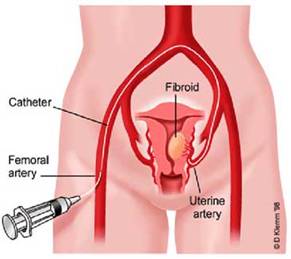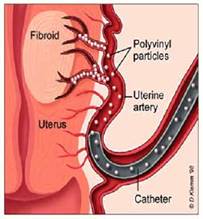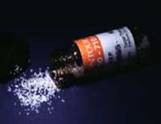Who Should Not Have UFE?
- No fibroid-related symptoms
- Suspicion of malignancy
- Infection or pelvic inflammatory disease
- Pregnant women
- Post-menopausal women
Who is a Potential Candidate for Ufe?
- Women with symptomatic fibroids: heavy bleeding, pelvic pain, bulk related symptoms, urinary frequency, pain during intercourse.
- Women for whom myomectomy or hysterectomy has been recommended
- Women who have a desire to preserve their uterus
- Women desiring to avoid major surgery
- Women desiring to maintain fertility, if hysterectomy is the only option
 What does the Embolization Look Like?
What does the Embolization Look Like?
Drawing of a catheter within the uterine artery and embolization of the arteries that supply the fibroids.
How does UFE Work?
- Inject particles into the ateries that supply the fibroids
- This starves the fibroids by compromising blood flow to fibroids
- Fibroids shrink
- Symptoms are eliminiated or significantly improved for 90% of women
 What is an Angiography Suite?
What is an Angiography Suite?
Using modern state-of-the-art digital imaging equipment, the Interventional Radiologist works in a sterile environment. The suite looks much like an operating room, except that high-tech imaging equipment is used to help guide the doctor.
What Tools do We Use to Guide Us into the Uterine Fibroids?
 |
 |
 |
 |
 |
| Angiographic Catheters | Guidewires | Microwires | Embosphere Particles | |
What Are Uterine Fibroid Embolization's Success Rates?
- 85-90% of women have reported complete or nearly complete improvement of symptoms, especially bleeding.
- 85-90% of women demonstrate on average 50-70% shrinkage in uterine and fibroid volume in 3-12 month follow-up
- over 90% of women reported satisfaction with the procedure
What are the Advantages of UFE?
- Treats all fibroids simultaneously
- Minimally invasive, complications infrequent
- Short recovery period
- No adhesion (scar) formation
- Minimal blood loss. No need for transfusion
- Emotionally, physically and sexually - UFE can have advantage over other treatments
What are the Disadvantages of UFE?
- 10-15% do not respond despite technical success
- Up to 2% of procedures technically unsuccessful
- Pelvic pain or cramping after procedure can remain moderate to severe for several days in a small group of patients.
- 1% chance of serious complication, i.e. hysterectomy
- No tissue obtained for pathologic diagnosis
What are the Risks of UFE?
- Hysterectomy: 1% incidence due to uterine infection or infarction.
- Premature ovarian failure: 10% of patients experience amenorrhea. Most in late 40's.
- Radiation not considered dangerous
- Serious dye allergy is extremely rare
- Catheter related complications are rare in experienced hands
Will UFE Decrease Fertility?
- Conclusive studies with large numbers lacking
- Dozens of reported healthy pregnancies, with no reports of any adverse outcome due to UAE
- If infertility due to fibroids, fertility may improve in select patients after UAE. Research ongoing.
- Women with symptomatic fibroids desiring fertility probably should consider myomectomy first, especially if relatively uncomplicated.
